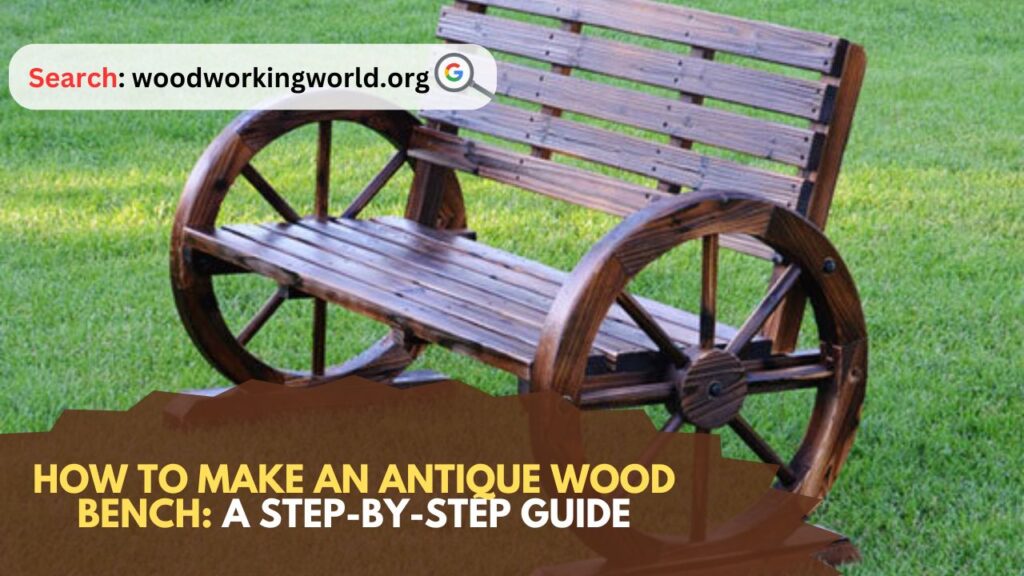Antique Wood Bench: Creating an antique wood bench is a rewarding woodworking project that adds a touch of classic charm to any space. Whether you’re an experienced woodworker or a DIY enthusiast, this project can be both fun and fulfilling. In this guide, we’ll walk you through the process of making an antique wood bench from start to finish.

How to Make an Antique Wood Bench
Materials and Tools You’ll Need
Before diving into the project, it’s essential to gather all the materials and tools you’ll need. Here’s a comprehensive list:
Materials:
- Wood: Choose hardwoods like oak, maple, or cherry for durability and authenticity.
- Wood Glue: For joining pieces together.
- Wood Screws: To secure the structure.
- Antique Wood Stain: To give your bench an aged look.
- Varnish or Polyurethane: For finishing and protecting the wood.
Tools:
- Measuring Tape
- Circular Saw or Handsaw
- Miter Saw
- Drill
- Screwdriver
- Clamps
- Sanding Sponge or Sandpaper (various grits)
- Paintbrushes
- Wood Chisel (optional)
Step-by-Step Instructions
1. Designing Your Bench
Before you begin, you need to decide on the design of your antique wood bench. You can opt for a traditional straight bench or something with more intricate details. Sketch out your design on paper, including dimensions and features like armrests, a backrest, or decorative carvings.
Basic Dimensions for a Standard Bench:
- Length: 4 to 6 feet
- Width: 12 to 18 inches
- Height: 18 to 24 inches from the ground
2. Selecting and Preparing Wood
Once you have your design, choose the right wood. For an antique look, select wood with rich grain patterns and a bit of natural wear. Visit a lumber yard or woodworking store to find suitable boards.
Preparation Steps:
- Measure and Cut: Cut your wood to the required dimensions. You will need pieces for the seat, legs, and supports.
- Dry Fit: Lay out the pieces to ensure they fit together as planned.
3. Constructing the Bench Frame
Start by building the frame of your bench, which will provide the structure and support for the seat.
Steps:
- Cut the Leg Pieces: Cut four pieces for the legs. Each leg should be the same length for stability.
- Attach the Seat Supports: Cut two pieces for the supports that will hold the seat. Position them between the legs at the top and attach using wood screws and wood glue. Ensure the supports are level and square.
Tip: Use clamps to hold the pieces in place while you drill and screw them together.
4. Building the Bench Seat
Next, you’ll create the seat of the bench.
Steps:
- Cut the Seat Board: Cut a single large piece of wood for the seat. It should be long enough to accommodate the length of the bench.
- Attach the Seat: Place the seat board on top of the supports and secure it with wood screws from underneath.
Tip: For added comfort, you can sand the seat board to ensure there are no rough spots.
5. Adding Antique Details
To give your bench an antique look, you can add various details.
Techniques:
- Distressing the Wood: Use a hammer, screwdriver, or chains to create dents and scratches on the wood.
- Carving: If you’re skilled in woodworking, consider adding intricate carvings or designs to the backrest or sides.
- Using an Antique Stain: Apply a wood stain that mimics the look of aged wood. Follow the manufacturer’s instructions for application and drying times.
6. Finishing Touches
The final step is to apply a finish that will protect the wood and enhance its antique appearance.
Steps:
- Sand the Bench: Use fine-grit sandpaper to smooth out any rough areas and prepare the surface for staining.
- Apply the Stain: Use a brush to apply the antique wood stain. Allow it to penetrate the wood for a few minutes before wiping off the excess with a clean cloth.
- Seal the Wood: Once the stain is dry, apply a coat of varnish or polyurethane to protect the wood and add a glossy finish.
Tip: Apply multiple coats of varnish, sanding lightly between coats for a smooth finish.
7. Maintaining Your Antique Wood Bench
To keep your antique wood bench looking beautiful for years to come, follow these maintenance tips:
- Regular Cleaning: Dust the bench regularly to prevent dirt buildup.
- Reapply Finish: Over time, the finish may wear off. Reapply varnish or polyurethane as needed.
- Avoid Excessive Moisture: Keep the bench in a dry area to prevent warping and damage.
Tips for a Successful Project
- Plan Thoroughly: A detailed plan and design will save you time and effort during construction.
- Take Your Time: Rushing through the project can lead to mistakes. Take your time with each step for the best results.
- Use Quality Materials: High-quality wood and supplies will ensure that your bench is durable and long-lasting.
- Safety First: Always wear safety goggles and gloves when working with power tools and wood.
Conclusion: Antique Wood Bench
Building an antique wood bench is a satisfying woodworking project that combines craftsmanship with creativity. By following this guide, you can create a beautiful and functional piece of furniture that enhances the charm of any space.
Remember to plan your design carefully, use quality materials, and take your time with each step. With patience and attention to detail, you’ll end up with a stunning antique wood bench that you can be proud of for years to come.
Happy woodworking!
I hope this article on Antique Wood Bench has been helpful. If you have any further questions, please feel free to leave a comment below.
Video
